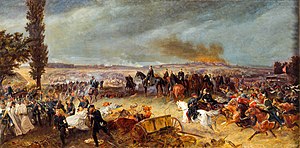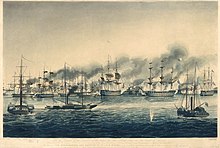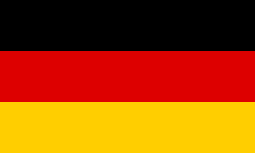| Prussian Crisis of 1849 | |||||||
|---|---|---|---|---|---|---|---|
| Part of the German Civil War, Revolutions of 1848 | |||||||
 The Battle of Königgrätz, by Georg Bleibtreu. Oil on canvas, 1851 | |||||||
| |||||||
| Belligerents | |||||||
|
The Allied Powers:
|
The Holy Alliance: | ||||||
- ^ a b Part of the German Empire as well
| Austrian Civil War | ||||||||
|---|---|---|---|---|---|---|---|---|
| Part of the German Civil War, Revolutions of 1848 | ||||||||
| ||||||||
| Belligerents | ||||||||
|
Pro-Government Forces:
|
Revolutionaries: | |||||||
|
Julyists:
|
Anti-July Revolutionaries: |
Counter-Revolutionaries: | ||||||
| Oriental War | ||||||||
|---|---|---|---|---|---|---|---|---|
| Part of Second Hundred Years' War, Russo-Turkish Wars | ||||||||
 The bombardment and capture of St Jean D'Acre | ||||||||
| ||||||||
| Belligerents | ||||||||
|
|
Phase 1 | |||||||
|
|
Phase 2:
Double Entente: Supported By: |
Russia Alligned Powers: | ||||||
|
|
Phase 3: |
| ||||||
 | |
| Use | National flag |
|---|---|
| Proportion | 2:3 |
 | |
| Use | Civil ensign |
| Proportion | 2:3 |
 | |
| Use | State flag |
| Proportion | 2:3 |
 | |
| Use | State ensign |
| Proportion | 2:3 |
 | |
| Use | War flag |
| Proportion | 1:1 |
 | |
| Use | Naval ensign |
| Proportion | 1:1 |
German Empire | |||||||
|---|---|---|---|---|---|---|---|
| 1848- | |||||||
| Motto: Ehrlichkeit, Einheit, Freiheit "Honesty, Unity, Freedom" | |||||||
| Anthem: O Deutschland hoch in Ehren | |||||||
| Status | Federation | ||||||
| Capital | Frankfurt Vienna (Imperial Residence) | ||||||
| Official languages | German | ||||||
| Religion | Official: Catholic Recognized: Lutheran, Reformed, Other Christian Unrecognized: Jewish | ||||||
| Demonym(s) | German | ||||||
| Government | Federal parliamentary constitutional monarchy | ||||||
| Emperor of the Germans | |||||||
• 1849- | Franz Joseph I | ||||||
| Legislature | Imperial Diet ("Reichstag") | ||||||
| House of the States | |||||||
| House of the People | |||||||
| Historical era | Concert of Europe | ||||||
| 1848- | |||||||
| 28 March 1849 | |||||||
| 16 July 1849 | |||||||
| 28 July 1849 | |||||||
| 2 February 1850 | |||||||
| Currency | Vereinsthaler | ||||||
| |||||||


